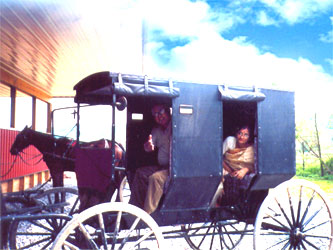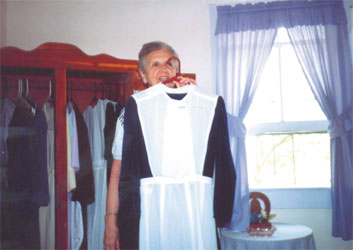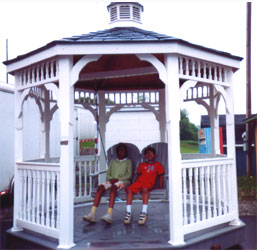| |
AMIABLE AMISH
A visit to an Amish farm can help dispel any prejudices you may have about this closed Christian community. In their obsessive
love for their children and emphasis on a cohesive family structure they seem, well, almost Indian.
By Sagoree Chatterjee in Wooster

|
|
As I steered towards the countryside a little beyond Wooster in Ohio on Interstate 71, a cavalcade of
horse
drawn carriages caught my sight. Riding the buggies were men and women as well
as youngsters attired in a manner out of sync with contemporary America. Animal
drawn carriages ferrying people from place to place were the last thing I had
expected to see in the center of a high-tech country such as the US. But there
was more. I was told this was
Amish (nothing to do with the Sanskrit word for non -
vegetarian ) |
country where you come face to face with people whose lifestyle
is markedly different from that of fellow Americans. Fired by curiosity, we
drove along rural roads, and in no time were deep inside Holmes County where the
houses, barns and farms looked exactly like the pictures I had seen of
19th century Europe. Not far away was an open air display of handcrafted Amish furniture, miniature houses made entirely of wood, and
other articles.
The Amish are different not only in sartorial styles but a whole lot of other things. It is easy to tell them as a group
apart. The garments their men and women as well as boys and girls wear distinctly bear the stamp of the 19th and
early 20th centuries. We saw many Amish women attired in their trademark outfit-an apron stuck to a flowing gown
and a triangular cape on the head. Vests, coats and loose trousers, called barn
door britches, held by suspenders at the
waist, are the standard outfit for men as well as boys.
The fabric may be blended polyester, but the basic pattern of the garments has not changed for generations. The color is invariably solid, for garish
hues are forbidden. Amish men often wear wide brimmed black felt or straw hats, and have
standardized hair styles and flowing beards. We did not see a single
woman with trimmed hair; they braid and knot it at the back.
Buggies are not the only things quaint about the Amish. There are no telephones, radio or TV in Btheir homes. If necessary they go to public phone
booths, which are not many either. The automobile is not used except for moving merchandise, handicrafts, and quilts in striking geometric patterns or artistically
carved wood furniture to the marketplace. The computer age has yet to make inroads into Amish life. The tools they use are simple.
|
Fossil energy is sparingly used in Amish households. There are no electric powered appliances, and stoves and fridges run on bottled gas. Oil lamps and
lanterns are common, and central heating, a common feature in American households, is non-existent in Amish residences. They make their own butter and
cheese. The women spin yarn and weave fabrics, and stitch all the family clothing on old fashioned sewing machines.
Horses and mules plough Amish farms and carry field implements. The average
Amish farm size—55 acres—is much smaller than most mechanized farms in the US.
Their cultivation methods aerate rather than compact the soil. They believe fqrm
aninals animals are far more economical than gas guzzling
tractors For fertilizer, the Amish use manure. They rely on the
|
|
 An Amish woman displays a young girl’s costume
An Amish woman displays a young girl’s costume |
nature more than any
other energy source. Almost every farm has a windmill to draw water and pump it
up.
The Amish, who derive their name from Jacob Amman, a leader of the Swiss Brethren of the late 17th century, have been an enigma to the rest of the
world since the beginning of the Anabaptist movement. Amish forefathers sought refuge in America from religious persecution in Germany
and Switzerland. The first Amish settlement is believed to have sprouted in Pennsylvania in 1737. Immigration to the US continued until the 19th century.
An estimated 125,000 of them now live in 20 or so states in the US, the largest settlements being in Ohio.

A gazebo in an Amish home |
|
Although the Amish do not actively seek new members, their communities have grown because they have large families, averaging seven or eight
children. They believe the Bible teaches a life of simplicity and a distinct separation between church and state. Pacifism permeates every aspect of their
life. Though devout Christians, the Amish do not build church towers; the church is located usually in the home. Many of them even now follow the
ancient custom of washing the feet of the elderly. Virtually every Amish home has a special corner alongside the Bible for the Martyr’s Mirror, a
book chronicling Amish history.
Until about a century ago Amish and non-Amish
children used to attend common one-room schools. But the Amish viewed the
consolidation of schools into
|
larger educational districts in the early years of
the 20th century as detrimental to their way of life, and began to put their
children in schools close to their homes. Amish children study the same subjects
as others do. The main difference now is the teaching of German in Amish
schools. The Amish view children as the Lord’s gift and frown on contraception.
Children accompany their parents wherever they go, put on Amish dress and learn
to speak the Pennsylvania German dialect in their mothers’ lap, which serves as
a very important cultural and bonding medium. They learn to take responsibility
early. It isn’t uncommon for a five-year old to walk down the village road with
a can of milk to a neighbor’s house or steer a wagon.
Until their early twenties, when they are baptized, Amish youth have the freedom to decide whether or not to join the church. Once baptized, they are expected to
stick to the rules of the church. All the girls turning 16 in one calendar year are often close buddies. Dating is allowed at 16 but many Amish young men spend a
couple of years or more socializing with girls before choosing their life’s partner.
Buggies are not the only things quaint about the Amish. There are no telephones, radio or TV in their homes.
The computer age has yet to make inroads into Amish life. The tools they use are simple. There are no electric powered
appliances, and stoves and fridges run on bottled gas.
|
Lifestyle standards are determined by one’s group or church district. The 20-30 households in each are geographically close enough to travel to each other’s
home for Sunday morning preaching in German or Dutch dialects. Church is held every alternate week; other Sundays are spent resting and
visiting.
The Amish generally detest the commercial use of the community's name to promote sales, and are disappointed if tourists remember them
only for thrifty farms, quilts and handicrafts. And that is what we returned with. The grand finale of our tour of Amish country was a hearty meal
at Der Dutchman, a well designed restaurant where Amish ladies in traditional dresses “man” the reception counter, and treat guests to delicious
Amish cuisine. Clearly, in this Age of Technology, the Amish provide more than just food for thought.
|
|